Utilization of Natural Zeolite and Perlite as Landfill Liners for in Situ Leachate Treatment in Landfills
Abstract
:1. Introduction
2. Materials and Methods
2.1. Properties of the Materials
2.1.1. Natural Zeolite
| Elemental Oxide | Weight % | ||
|---|---|---|---|
| Bentonite | Natural Zeolite | Expanded Perlite | |
| Na2O | 1.8 | 0.40 | 3.29 |
| MgO | - | 1.40 | 0.18 |
| Al2O3 | 17 | 11.80 | 11.90 |
| SiO2 | 61 | 71.00 | 72.90 |
| P2O5 | - | - | 0.02 |
| CaO | 2.5 | 3.40 | 0.79 |
| TiO2 | - | 0.10 | - |
| MnO | 4 | - | 0.05 |
| K2O | 0.5 | 2.40 | 4.47 |
| F2O3 | 3 | 1.70 | 0.53 |
| SO3 | - | 0.12 | - |
| Loss on ignition(LOI) | 6 | 6.87 | 1.00 |
2.1.2. Expanded Perlite
2.1.3. Bentonite
2.2. Obtaining and Preparing of the Solid Wastes Sample to Experiments
| Composition | Weight % |
|---|---|
| Organic Waste | 80.6 |
| Paper-Cartoon | 6.10 |
| Nylon-Plastic | 8.06 |
| Metal | 2.01 |
| Glass | 3.23 |
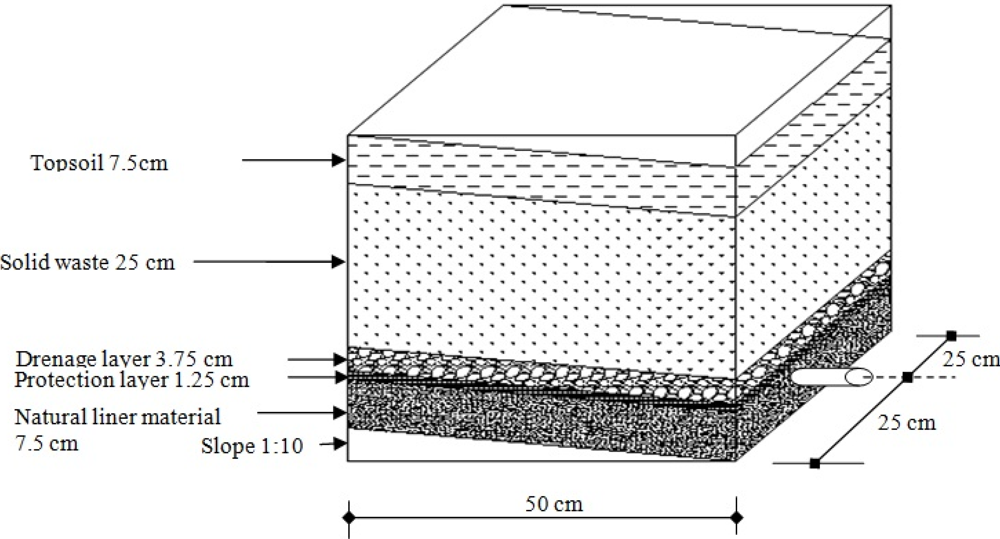
| System | Components |
|---|---|
| System 1 | Solid Waste (25 cm) |
| System 2 | Natural. Zeolite (7.5 cm) + Sand (1.25 cm) + Gravel (3.75 cm) + Waste (25 cm) + Topsoil (7.5 cm) |
| System 3 | Expanded Perlite (7.5 cm) + Sand (1.25 cm) + Gravel (3.75 cm) + Waste (25 cm) + Topsoil (7.5 cm) |
| System 4 | Bentonite (7.5 cm) + Sand (1.25 cm) + Gravel (3.75 cm) + Waste (25 cm) + Topsoil (7.5 cm) |
3. Experimental Results
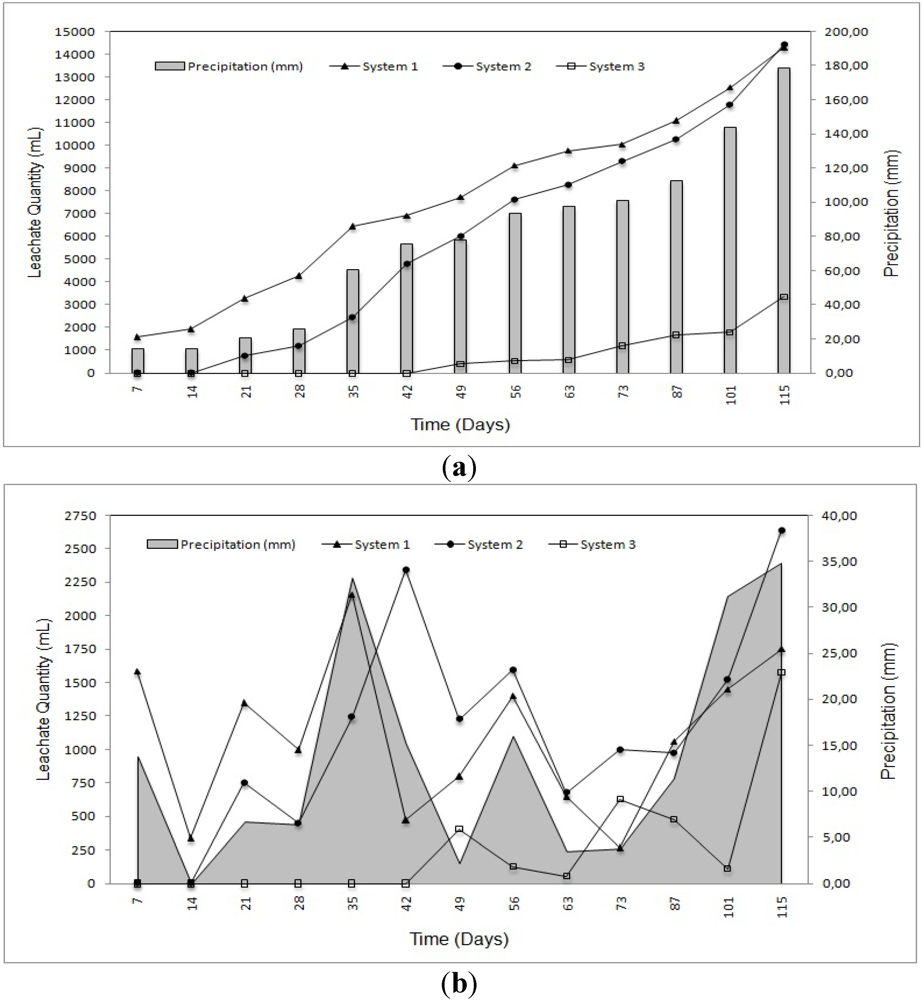
| Parameters | pH | EC (μS/cm) | NO3-N (mg/L) | NH4-N (mg/L) | PO4 (mg/L) | COD (mg/L) |
|---|---|---|---|---|---|---|
| System 1 | 6.73–8.58 | 6,040–11,750 | 17.1–40.9 | 10.5–102.6 | 63.7–178.9 | 4,388–9,761 |
| Tchobanoglous ,1993 [2] | 6 | - | 25 | 1–1,500 | 20 | 18,000 |
| Andreottola,1992 [20] | 5.3–8.5 | - | 1.5–50 | 0.3–25 | 150–100,000 | |
| SWANA, 2004, [21] | 6.8 | 12,000 | - | 1,180 | 20,000 | |
| SWANA, 2004, [21] | 7.2 | 25,000 | - | 910 | 5,600 |
| Removal Efficiencies (%) | ||
|---|---|---|
| System 2 | System 3 | |
| Leachate quantity | 24.70 | 55.00 |
| NO3-N | 91.20 | 83.20 |
| NH4-N | 95.60 | 1.50 |
| PO4-P | 95.50 | 91.00 |
| COD | 83.40 | 62.50 |
| Organic matter | 87.80 | 48.70 |
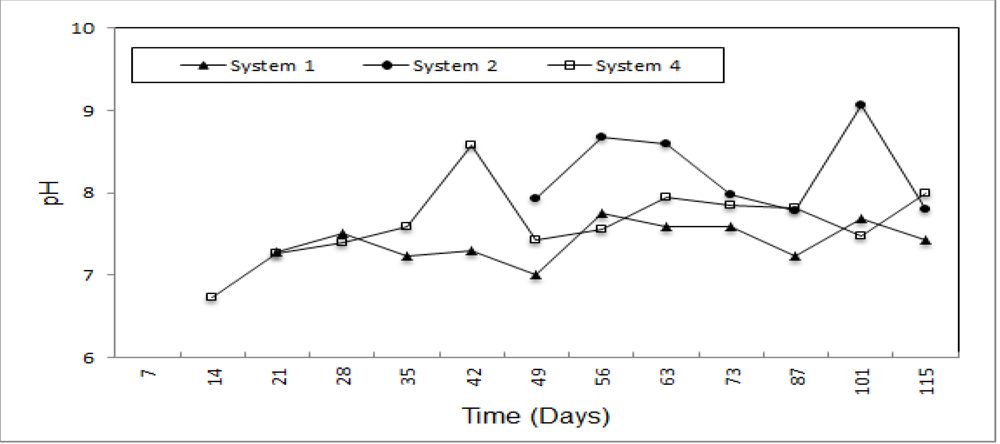
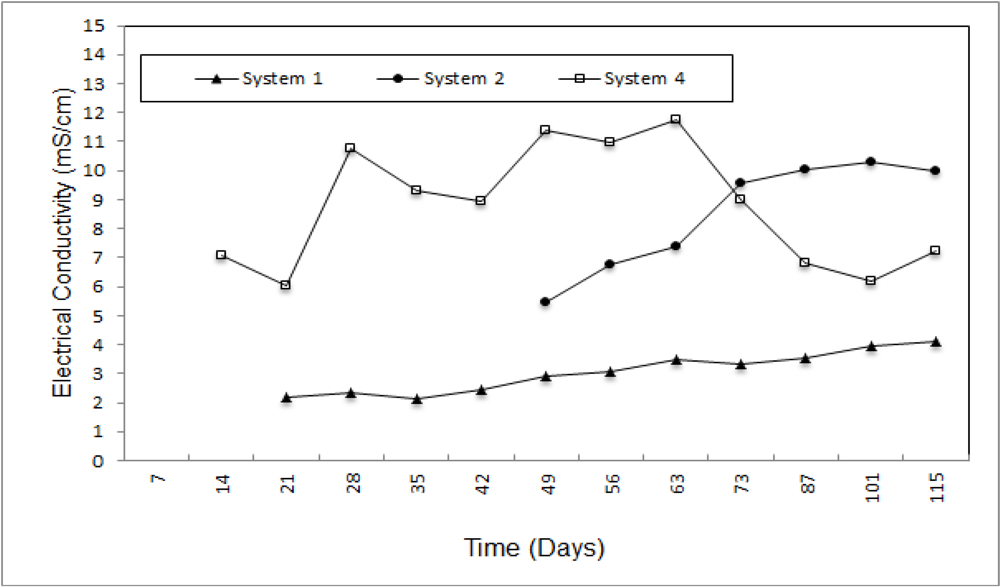


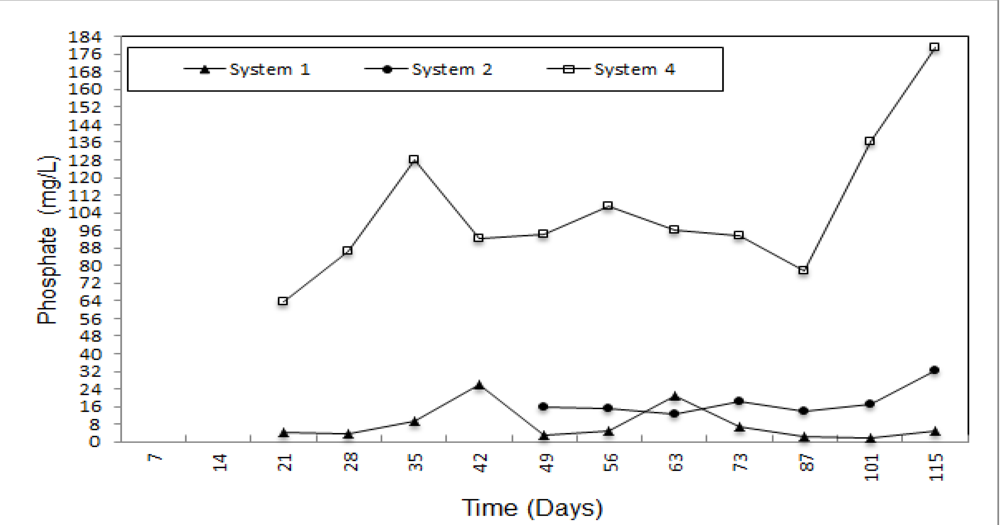
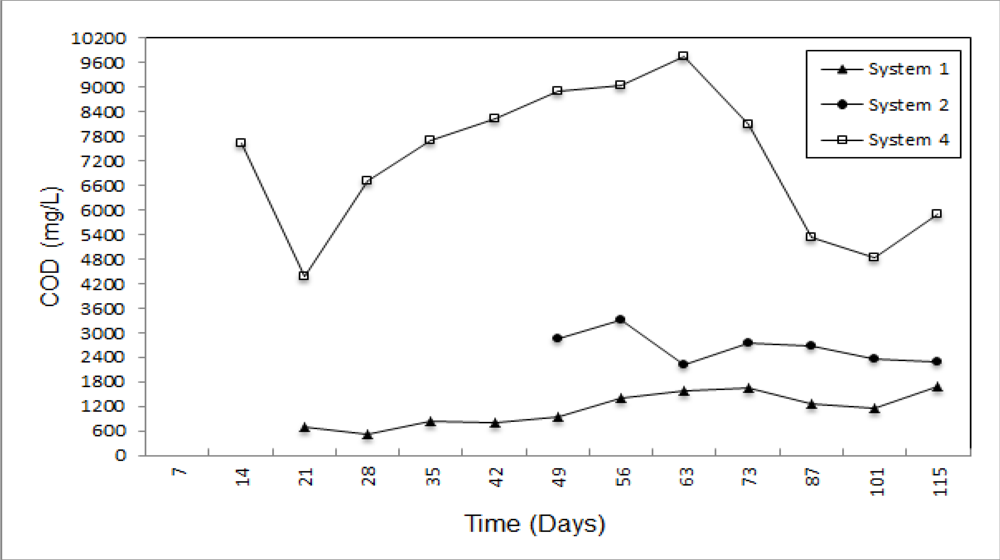
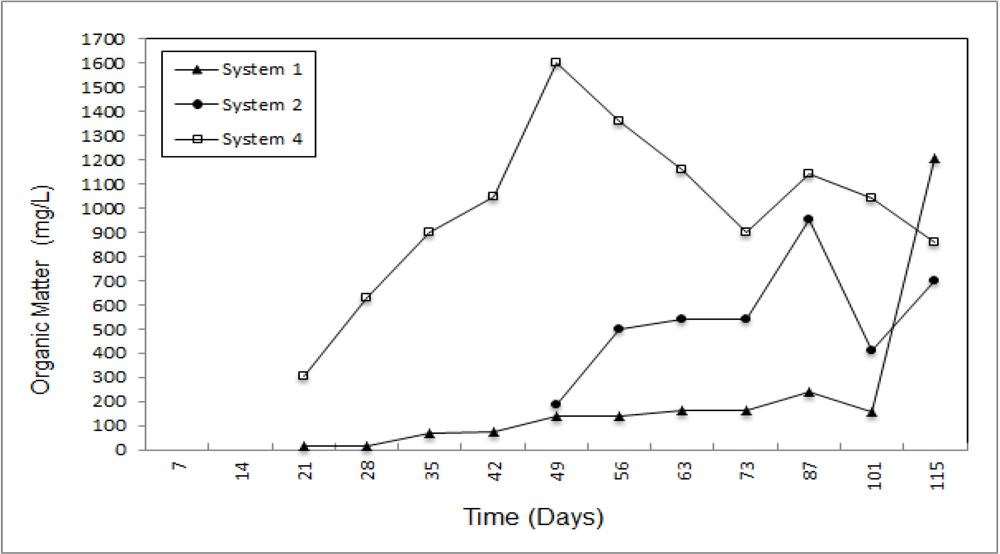
4. Conclusions
References
- Ozel, U.; Koc, T.; Berkun, M. Integrated Solid Waste Disposal System for Southeastern Black Sea Coastal Region. In Proceedings of the Black Sea International Environmental Symposium, Giresun, Turkey, 25–29 August; 2008. [Google Scholar]
- Tchobanoglous, G.; Theise, H.; Vigil, S.A. Integrated Solid Waste Management; McGraw-Hill International Editions: Singapore, 1993. [Google Scholar]
- Koerner, R.M.; Soong, T.Y. Leachate in landfills: The stability issues. J. Geotext. Geomembr. 2000, 18, 293–309. [Google Scholar]
- Christensen, T.H.; Cossu, R.; Stegmann, R. Principles of Landfill Barrier Systems, Landfill of Waste: Barriers; Christensen, T.H., Cossu, R., Stegman, R., Eds.; E & FN SPON: New York, NY, USA, 1992. [Google Scholar]
- Kayabali, K. Engineering aspects of a novel landfill liner material: Bentonite-amended natural zeolite. Eng. Geol. 1997, 46, 105–114. [Google Scholar]
- Williams, P.T. Waste Treatment and Disposal; John Wiley Sons Ltd: Hoboken, NJ, USA, 2005; pp. 192–193. [Google Scholar]
- Rodrigo, N.; Hafner, G.; Raber, G.; Lorber, K.; Schoffmann, E.; Vortisch, W. The use of volcanic soils as mineral liner-I, Physicochemical characterization and comparison with zeolites. Waste Manag. Res. 2005, 23, 249–259. [Google Scholar]
- Czurda, K. Clay Liners and Waste Disposal, Handbook of Clay Science; Bergaya, F., Theng, B.K.G., Lagaly, G., Eds.; Elsevier Ltd.: Amsterdam, The Netherlands, 2006; pp. 693–701, Developments in Clay Science Vol. 1. [Google Scholar]
- Kaya, A.; Durukan, S. Utilization of bentonite-embedded zeolites as clay liner. Apppl. Clay Sci. 2004, 25, 83–91. [Google Scholar]
- Tuncan, A.; Tuncan, M.; Koyuncu, H.; Güney, Y. Use of natural zeolites as a landfill liner. Waste Manag. Res. 2003, 21, 54–61. [Google Scholar]
- Yang, T.R. Adsorbents: Fundamentals and Applications; Wiley-Intescience: Hoboken, NJ, USA, 2003. [Google Scholar]
- Ciullo, P.A. Industrial Minerals and Their Uses, A Handbook & Formulary; Noyes Publication: Park Ridge, NJ, USA, 1996. [Google Scholar]
- Doğan, M.; Alkan, M.; Cakir, U. Electrokinetic properties of perlite. J. Colloid Interface Sci. 1997, 192, 114–118. [Google Scholar]
- Pivato, A.; Raga, R. Tests for the evaluation of ammonium attenuation in MSW landfill leachate by adsorption into bentonite in a landfill liner. Waste Manag. 2006, 26, 123–132. [Google Scholar]
- Gala, N.E. Genesis of Clay Minerals, Handbook of Clay Science; Bergaya, F., Theng, B.K.G., Lagaly, G., Eds.; Elsevier Ltd.: Amsterdam, The Netherlands, 2006; pp. 1129–1162, Developments in Clay Science Vol. 1. [Google Scholar]
- McBean, E.A.; Rovers, A.F.; Farquhar, J.G. Solid Waste Landfill Engineering and Design; Prentice-Hall, Inc.: Upper Saddle River, NJ, USA, 1995. [Google Scholar]
- Rowe, R.K.; Quigley, R.M.; Booker, R.J. Clayey Barrier Systems for Disposal Facilities; Chapman Hall: London, UK, 1995. [Google Scholar]
- Ozel, U. Effects of Natural Materials as Landfill Liner in Sanitary Landfill on Chemical and Biological Parametres of Leachate. Master Thesis, Natural Sciences Institutes, Ondokuz Mayis University Science, Samsun, Turkey, 2007. [Google Scholar]
- APHA, AWWA, WEF. Standart Methods for the Examination of Water and Waste Water; Clesceri, L.S., Greenberg, A.E., Eaton, A.D., Eds.; American Public Health Association: Washington, DC, USA, 1999.
- Andreottola, G.; Cannas, P. Chemical and Biological Characteristics of Landfill Leachate, Landfilling of Waste:Leachate; Christensen, T.H., Cossu, R., Stegmann, R., Eds.; Elsevier Ltd: Amsterdam, The Netherlands, 1992. [Google Scholar]
- SWANA. The Effectiveness of Municipal Solid Waste Landfills in Controlling Releases of Heavy Metals to the Environment. Report of the SWANA Applied Research Foundation Disposal Group Subscribers; Solid Waste Association of North America: Silver Springs, MD, USA, 2004.
- Al Sabahi, E.; Rahim, S.A.; Zuhairi, W.Y.W.; Al Nozaily, F.; Alshaebi, F. The characteristics of leachate and groundwater pollution at municipal solid waste landfill of Ibb city, Yemen. Am. J. Environ. Sci. 2009, 5, 256–266. [Google Scholar]
- Johannessen, M.L. Guidance Note on Recuperation of Landfill Gas from Municipal Solid Waste Landfills. Urban Development Division; Urban Waste Management Thematic Group, The International Bank for Reconstruction and Development, The World Bank: Washington, DC, USA, 1999. [Google Scholar]
© 2012 by the authors; licensee MDPI, Basel, Switzerland. This article is an open-access article distributed under the terms and conditions of the Creative Commons Attribution license (http://creativecommons.org/licenses/by/3.0/).
Share and Cite
Ozel, U.; Akdemir, A.; Ergun, O.N. Utilization of Natural Zeolite and Perlite as Landfill Liners for in Situ Leachate Treatment in Landfills. Int. J. Environ. Res. Public Health 2012, 9, 1581-1592. https://doi.org/10.3390/ijerph9051581
Ozel U, Akdemir A, Ergun ON. Utilization of Natural Zeolite and Perlite as Landfill Liners for in Situ Leachate Treatment in Landfills. International Journal of Environmental Research and Public Health. 2012; 9(5):1581-1592. https://doi.org/10.3390/ijerph9051581
Chicago/Turabian StyleOzel, Ummukulsum, Andaç Akdemir, and Osman Nuri Ergun. 2012. "Utilization of Natural Zeolite and Perlite as Landfill Liners for in Situ Leachate Treatment in Landfills" International Journal of Environmental Research and Public Health 9, no. 5: 1581-1592. https://doi.org/10.3390/ijerph9051581




